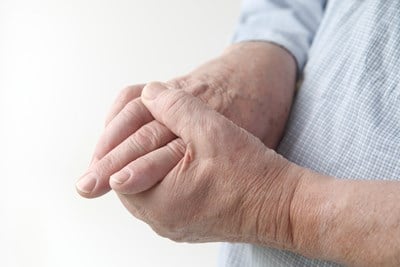You may have always thought of rheumatoid arthritis as a condition exclusively experienced by adults, especially elderly people, but many children also suffer from this chronic autoimmune disease. The American College of Rheumatology estimates that about one in 1,000 children will develop some type of juvenile arthritis. According to the Arthritis Foundation, the most common type of arthritis that affects children aged 16 and younger is juvenile rheumatoid arthritis (JRA).
Juvenile vs. Adult
The name might suggest that juvenile rheumatoid arthritis is simply a "kid version" of adult rheumatoid arthritis, but his is not the case. Whereas adult rheumatoid arthritis primarily affects the smaller joints, JRA often starts in the larger joints and affects the eyes and skin as well. Furthermore, treatments differ in that JRA is managed much more aggressively so that a child’s growth and skeletal development are not impacted.
There are enough differences between adult and juvenile rheumatoid arthritis that experts believe it should be treated as an altogether separate condition. Specialists have shifted toward using a more distinctive term: juvenile idiopathic arthritis (JIA). Idiopathic means the cause of the condition is unknown. Arthritis, by the way, means joint inflammation. Juvenile rheumatoid arthritis is also sometimes referred to as juvenile chronic arthritis, though not as often in the United States.
Symptoms
JIA is characterized by inflammation in one or more joints for at least six weeks. According to the Mayo Clinic, the following are the most common signs of juvenile idiopathic arthritis:
- pain in the joints—especially after a nap or first thing in the morning.
- swelling of the joints—initially noticeable in larger joints, such as the knee.
- stiffness of the joints—mostly noticeable after a night of sleep or a nap.
Many children are diagnosed with juvenile arthritis between the ages of one and four years old. Children this young may experience difficulty pinpointing and reporting symptoms such as pain and stiffness. Because of this, you may want to look for limping, clumsiness, or lacking fine motor function—especially following periods of immobility.
Other symptoms of JIA may include:
- avoidance of using a certain limb
- reduced fine motor function
- inactivity
- recurring fever
- skin rash
Symptoms vary by the subtype of juvenile idiopathic arthritis. Sources vary too on how many types of JIA there are. According to the American College of Rheumatology, these are the most common subtypes of JIA:
- Systemic: This type affects 10% of children with arthritis, and it affects boys and girls equally. The whole body is affected. Fever, rash, and anemia might accompany joint, eye, and internal organ swelling.
- Oligoarticular: This type affects nearly 50% of children with arthritis, and it affects more girls than boys. With this type, four or fewer joints will be affected. The iris of the eye is particularly susceptible with this type—even with JIA symptoms have receded. Some children may have arthritis that persists into adulthood.
- Polyarticular: This type is the least common, and it resembles adult rheumatoid arthritis more than any other. It affects five or more joints. The risk of joint damage is the highest with this type.
- Enthesitis-related: This type is associated with juvenile ankylosing spondylitis, a condition characterized by inflammation of the lower spine. Gastrointestinal involvement is common with this type, so your child may also have conditions such as irritable bowel syndrome or Crohn’s disease, for example.
Risk Factors and Causes
JIA affects children from all races and backgrounds, but it does seem to affect more girls than boys. Until the cause is known, JIA remains unpreventable. It seems, according to experts, that children with JIA are born with a genetic predisposition for developing an autoimmune disfunction, which occurs when the immune system erroneously flags healthy cells within the body as if they were a disease and then attacks them.
It also seems that the onset of this autoimmune disease follows certain environmental factors, such as an illness. Researchers believe it is after such an event that the immune system begins to attack the lining of the joints.
Diagnosis and Treatment
JIA is rheumatological in nature, meaning it involves inflammation of the joints, connective tissues, and soft tissues. JIA is carefully diagnosed and best managed by a pediatric rheumatologist, a physician who specializes in treating rheumatological conditions in children.
Your child’s doctor should take a careful physical examination. An examination, along with a medical history, is the most critical component of JIA diagnosis. No single test alone can determine whether a child has juvenile rheumatoid arthritis, and he or she is given more for the purpose of ruling out other possible diagnoses such as cancer, Lyme disease, lupus, infections, or bone disorders.



